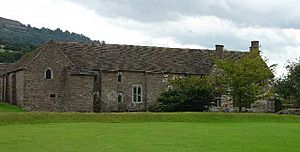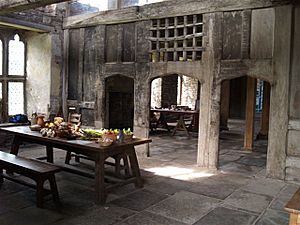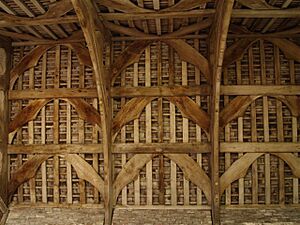Tretower Court facts for kids

Tretower Court - the West range
|
|
| Lua error in Module:Location_map at line 420: attempt to index field 'wikibase' (a nil value). | |
| Location | Tretower, Powys, Wales |
|---|---|
| Type | Historic house museum |
| Owner | Cadw |
Tretower Court (which is Llys Tre-tŵr in Welsh) is an old fortified house from the Middle Ages. It's located in the village of Tretower, near Crickhowell in Powys, Wales. This special building shows how a strong castle could change into a comfortable, yet still protected, home over time.
Contents
A Special Place in History
Tretower Court grew from the nearby Tretower Castle. It's a very rare example of how buildings changed in medieval times. It shows how a castle slowly became a different kind of important medieval building: a fortified manor house. This means it was a grand home that also had defenses.
It's also amazing that Tretower Court survived so well. Many old buildings were destroyed in wars, like the English Civil War. Others were partly damaged or completely rebuilt over the years. But Tretower Court remained mostly as it was, giving us a clear look into the past.
How Tretower Court Was Built
The first parts of Tretower Court were built in the early 1300s. At this time, the nearby castle was still being used too. The oldest part of the Court is the north section. Its stone walls, fireplaces, windows, and a special tower for toilets suggest it was built around 1300.
This 14th-century building had a large hall on the ground floor. This hall was open all the way up to its high roof. It also had a private bedroom, called a solar, and another private living room. The hall was probably used as a local court where people paid fines and taxes. The west section of the building was also built in the 14th century.
Facing Threats: Owain Glyndŵr's Revolt
In the early 1400s, during the Owain Glyndŵr revolt, Tretower Court faced a real danger. Owain Glyndŵr led a Welsh uprising against the new English King Henry IV. In 1404, Tretower Castle was listed as a strong place for the King's forces. Under Sir James Berkeley, the castle successfully defended against an attack. It's likely this attack was aimed at the castle, so the Court probably avoided serious damage.
In the same year, an English army led by Richard Beauchamp, Earl of Warwick fought Owain Glyndŵr's Welsh army. This battle happened nearby at Mynydd Cwmdu. The English almost captured Glyndŵr himself and took his flag. The Welsh forces then went down the River Usk valley. They set a trap for the English who were chasing them. A small fight happened near Craig-y-Dorth hill. The English army was chased all the way to the walls of Monmouth town.
Less than ten years later, Tretower Court became a meeting point. Local Welsh archers gathered here before going to France. They served under King Henry V and helped the English win the famous Battle of Agincourt.
Changes by the Vaughan Family
Long ago, the Picard family owned the castle. They received a lot of land for helping William the Conqueror. Later, around 1450, Sir Roger Vaughan was given the property. This happened through Sir William Herbert, who was the previous owner of the Court and Tretower Castle. The Vaughan family would own the property for many years during its most important period.
Sir Roger Vaughan became one of the wealthiest commoners in Wales. He immediately started to improve Tretower Court. He wanted it to be a grand home suitable for a rich man. The building we see today largely reflects his work.
He updated the north section, adding a floor above the main hall. This made it a two-story building. The lower floor was likely used for storage, with a kitchen at one end. He also added a new west section, which immediately doubled the living space. This new part included a brand new hall, a private bedroom, and other rooms upstairs.
Sir Roger Vaughan supported the Yorkist side during the Wars of the Roses in the mid-1400s. He fought in the Battle of Mortimer's Cross in 1461. After the battle, he led Owain Tudor to his execution. In 1465, he stopped an uprising in Carmarthenshire and was soon made a knight. In 1471, he chased Jasper Tudor after the Battle of Tewkesbury. However, Tudor captured him instead, and he was executed at Chepstow Castle.
Sir Roger Vaughan's son, Sir Thomas Vaughan, continued to improve the Court. In the late 1400s, he added a wall with battlements, walkways on top of the walls, and a gatehouse. These additions enclosed the courtyard.
More improvements were made in 1630 by Charles Vaughan. He was a sheriff of Brecknock in 1622 and 1636. He added cellars, a new staircase, and another entrance. The Court then passed to his son, Edward Vaughan. When Edward died without children, the estate went to his sister, Margaret. After that, the Court passed through a few more generations without major changes or improvements.
Decline and Restoration
In 1783, the Vaughan family sold the property. They decided to move to another one of their homes after a marriage. Tretower Court then had many new owners and tenants. Over time, some rooms that were once living spaces became storage areas, barns, and even places for animals, including a pigsty.
The building was not kept up as it had been before. By the early 1900s, Tretower Court was in danger of falling apart. The roof was especially weak. Any repairs that had been done were not very good and hid the building's true age and value.
In 1929, the Brecknock Society asked the government to buy the building. Their appeal was successful. In the 1930s, Tretower Court was saved and restored for the nation. Today, it is looked after by Cadw, which is the Welsh government's historic environment service.
Tretower Court is now open to the public. Visitors can take an audio tour to learn about its history. The entrance fee is small. Sometimes, special events and historical reenactments are held at the Court. Parts of the building can even be used for wedding ceremonies.
The Court was also used as a filming location in 2007 for an episode of The Sarah Jane Adventures called Eye of the Gorgon.
See Also
- List of gardens in Wales




